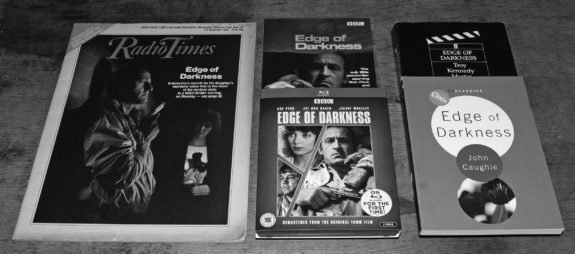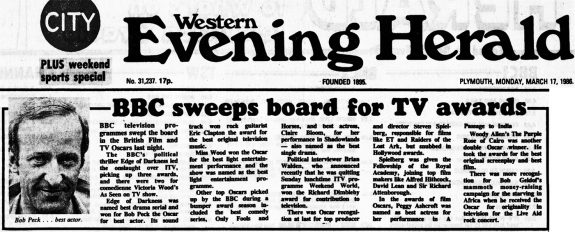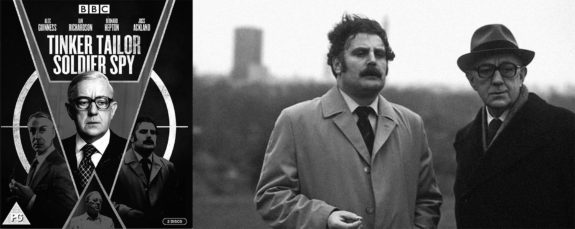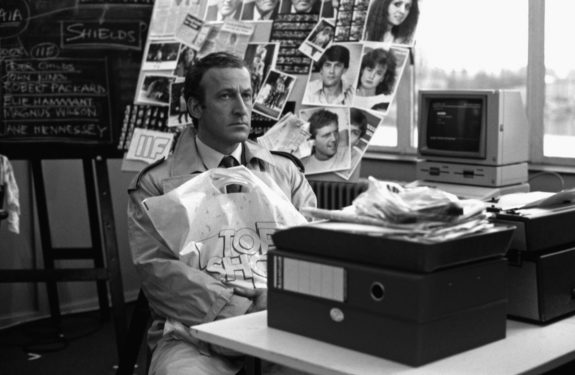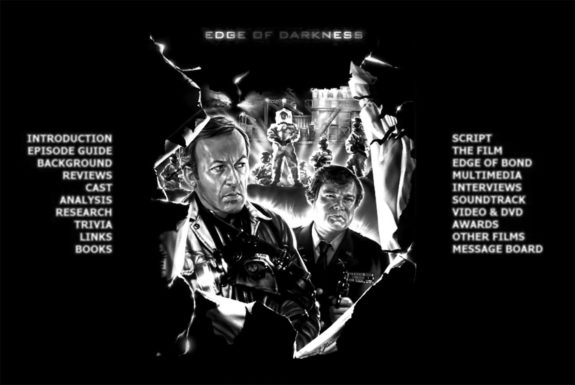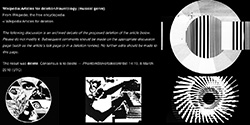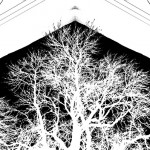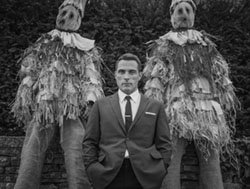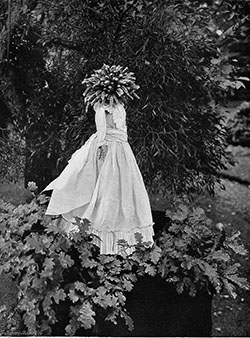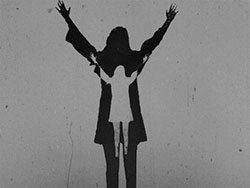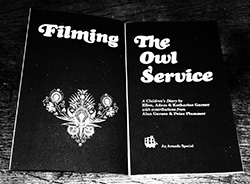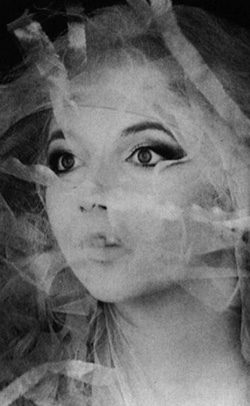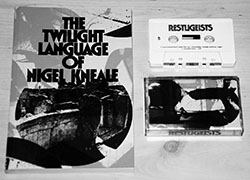Every now and again I check my shelves and I start to realise that something that started out as, say, just one DVD, has started to become a mini-collection.
Along which lines Edge of Darkness, which I now appear to have on DVD and Blu-ray, alongside a copy of the Radio Times from November 1985 with the series on the cover, John Caughie’s BFI released TV Classics book on the series, with an afterword by its writer Troy Kennedy Martin and the book of his script for the series, which amongst other extras includes a background to the events that preceded the series (I think I used to own the series on VHS as well but I’m not sure).
I seem to find myself collecting/seeking/gathering these kind of things in the way I once did different twelve inch releases and remixes of single once upon a time.
I’ve written about the series elsewhere at A Year In The Country and also in the Straying from the Pathways book but with recently rewatching it on Blu-ray I thought I would revisit it.
If you don’t know the series, it was written by Troy Kennedy Martin and originally broadcast on the BBC in 1985 and is a mixture of crime drama and eco/political thriller, in which a policeman called Ronald Craven attempts to unravel the truth behind the murder of his daughter. His investigations lead him into a murky world of government and corporate cover-ups, and as they proceed his sanity appears to crumble, while it is also slowly revealed that he may well have known his daughter was involved as an activist in that murky world and that he did not stop her. Heavily influenced by the political climate of the time, it notably explores the aura of secrecy surrounding the nuclear industry and the implications of the Gaia hypothesis of environmentalist and former NASA scientist James Lovelock, which posits that living organisms interact with their inorganic surroundings on Earth to form a synergistic and self-regulating, complex system that helps to maintain and perpetuate the conditions for life on the planet.
It is intelligent but also highly entertaining television, where real world, mythical and mystical elements intermingle and brings to mind some form of Arthurian Knight’s quest as Craven attempts to defeat those who possibly threaten the existence of all human life. There is a sense of dark forces being at play, which, as I say in Straying from the Pathways, are not supernatural but may be in part preternatural or beyond the realms of the day-to-day world.
To a certain extent the first four episodes are more conventional but during the 5th, and to a degree the 6th, episode the gloves come off and it becomes quite unhinged, almost hallucinatory in parts, possibly reflecting Craven’s descent into obsession, madness, in part due to his unresolved grief.
It went on to win multiple awards and due to it’s popularity was re-broadcast only around 6 weeks after it’s original showing, which was the fastest time between original broadcast and repeat in the BBC’s history. Back then that really was quite the thing and it’s hard to imagine just how significant and unusual that was in these days of constant broadcast and online repeats of programmes – or to give them their new name, catchup and TV on demand (!) (Thanks to Mat Handley of Pulselovers for pointing out the similarity of those.)
Even though much of the series is set in urban areas, I tend to think of it as being about the landscape, perhaps in part because of the way that the land is shown as containing layered, hidden subterfuges in a system of former mining tunnels below a rural area, where there are some decidedly shady and undeclared experiments taking place.
These sections are set in Yorkshire and because of that and their subterranean nature, both literal and figurative they bring to mind the hidden histories and settings of David Peace’s Yorkshire noir Red Riding crime novels, and also his occult (as in hidden) history of the 1984-1985 UK miners’ strike GB84, alongside the intriguing and oddly out of place rant about secret underground bases in Alan Clarke and David Rudkin’s visionary rural drama Penda’s Fen.
The way in which the series explores some similar territory as Penda’s Fen, and also its possible forebears in film and television, was discussed in an article written by Robert Hanks for the January 2020 issue of the BFI’s Sight & Sound magazine, that was included as an accompaniment to the series’ Blu-ray release:
“In its paranoia, its gleeful attitude to the apparatus of espionage, it’s bureaucracy and jargon… Edge of Darkness clearly owes a debt to John Le Carré, and no doubt memories of the success of the BBC’s 1979 Tinker Tailor Soldier Spy helped get it made. But inits emphasis on the environment, on soil and growth, in its invocation, via James Lovelock’s theories, of the earth godess Gaia, and in its questioning attitude to Britishness – to the relationship between the nation, the land it loves on and the state that controls it – it is much closer to the brilliant David Rudkin / Alan Clarke drama Penda’s Fen.”
As in Tinker Tailor Soldier Spy, particularly in the novel, that “gleeful attitude” to espionage in Edge of Darkness at points comes across as being nearer to those who have received an elite, probably private, education playing schoolboy-like games, although the reality of the situations and their possible outcomes have high stake and often deadly outcomes. This is particularly notable in relation to the character’s Pendleton and Harcourt that Craven becomes involved with, who act very much as freewheeling agents operating in a grey area of intelligence that is only nominally under the auspices and control of the state; they often seem to have and take a jokey, game playing attitude in regards to very serious matters which, at times, borders on the flippant approach of duo Mr Steed and Mrs Peel in the cartoonish espionage japes of the 1960s television series The Avengers.
Although, as I say in the Straying from the Pathways, the series “was produced and broadcast during, or just after, some of the turbulent events of the 1980s, it was not so much an exploration of hidden history but rather an attempt to explore, reveal or counterbalance hidden current events as well as the machinations of the hidden state and the actions of those in positions of power”. I think in some ways, in relation to this sense of hidden tales and history in the landscape, it is quite possibly one of the roots or inspirations for what has become A Year In The Country.
It must be said though that the depictions of the landscape/rural areas in the series rarely feel wide open and expansive. As with much of the series there is often a sense of both intimacy and claustrophobia.
The Blu-ray has only fairly recently been released and I think I managed to wait a whole week before giving in and buying it. I was slightly concerned about watching it as quite a few HD Blu-ray transfers of older films and television are often not done all that sympathetically. (And pardon me as I am now about to mildly geek out about Blu-ray transfers!)
In those releases where you get both the DVD and the Blu-ray I’ve at times found myself turning off the Blu-ray and putting on the DVD as the HD transfer can sometimes be just too harsh and unforgiving, the detail looks over harsh or too much. Which I never really understand in terms of HD transfers seeming overly detailed as, although traditional film and pixel counts aren’t directly comparable, if something was originally recorded onto film then effectively it has more detail in it than the 1080p in a Blu-ray.
On some transfers people’s skin looks waxy due to too much digital noise reduction (DNR) and, probably my least favourite, skin tones can be too pink/red – or even, as in a recent new 4K transfer I watched, their skin tones can keep varying throughout the transfer. I generally think a good transfer should be largely invisible; you shouldn’t even notice it all that much but just be able to sit back, appreciate and lose yourself in it.
 (Something of a time capsule view of the high street in Edge of Darkness.)
(Something of a time capsule view of the high street in Edge of Darkness.)
Anyways, fortunately the Edge of Darkness is a fine transfer and well worth a watch.
The Radio Times in my mini-Edge of Darkness collection is from November 1985 and took a fair bit of hunting down. There are a fair few copies of old Radio Times available online but there are a few that seem particularly rare, with this being one of them. The issue has a three page article on the series including quotes/an interview from it’s writer, in which he somewhat evocatively and succinctly describes the sense of subterfuges in the series by saying that Craven’s quest reveals the “silhouette” of modern British politics.
The cover image is something of a curio. It’s not taken from the series and makes it look as though it may well be a quite conventional detective or noir series. Which it really isn’t, although it does have noirish elements in the Chandler-esque sense of Craven being a lone untarnished knight attempting to right wrongs and defeat those with much more power and resources. Or if you take noir as being about desperate people doing desperate things and who will ultimately come undone, well, all that’s there to, along with noirish pouring rain and Craven in a noir-ish private eye-esque raincoat with the collar turned up. By the end of the series, as in some of Chandler’s Philip Marlowe stories, there is a sense that Craven has put himself through all kinds of hell and hardship and although he may have briefly cleaned up one small corner of corruption, and achieved some kind of minor victory, possibly merely for his own respect and dignity, while also making things a bit awkward for those higher-up in society’s hierarchy, ultimately things will continue how they always have.
Connected to which, in a manner that reminded me of some of John Le Carré’s espionage fiction writing, there is also a sense of a small group of powerful, possibly high-end public school/Oxbridge etc educated men playing at spy games. But these are games with deadly consequences.
Despite it’s sometimes heavy, dark themes as I mentioned previously, this is also highly entertaining television. It remembers to entertain in amongst it’s potentially heavy, dark themes. It’s tender at points and even quite humorous. This is notably so in some of the sections featuring Jedburgh, an American far-from secret agent who, despite his sometimes questionable morals and methods, is a big-hearted bluff man. He conspicuously wears a stetson in London and drives a white Rolls Royce (just to make sure he’s not undercover at all but hidden in plain sight), loves watching the British ballroom competition Come Dancing on television and one of his main aims in amongst the Cold War, and proxy shennanigans that he is involved in, appears to be to defend Britain’s golf courses no matter what (he also loves playing golf).
(I say about Edge of Darkness remembering to entertain with a pointed look at a lot of contemporary television drama, which curiously seems to equate heavy, unrelenting and dark atmospheres with entertainment, albeit without the more layered and nuanced political and other aspects that can be found in Edge of Darkness.)
In the Radio Times Troy Kennedy Martin discusses how he was sensitive to “the risk of overwhelming people with gloom:
“One of the problems is that, to a certain extent, everyone who’s writing about Thatcher’s Britain, particularly if they’re over a certain age, is unbelievably depressed about it. So they’re writing really heavy stuff… [Thanks to characters like Jedburgh the series] has humour to take the curse off it.”
There’s a website I’ve mentioned before dedicated to Edge of Darkness which, in a somewhat charming and time capsule way, has a “how the internet used to look” design. Even the website’s URL (http://fabulousbakers.tripod.com/edge/main.html) is now reminiscent of another age.
Anyways, the front page image on that website, pictured above, has a pulp thriller/science fiction-esque look to it, which seems almost wonderfully inappropriate for Edge of Darkness. I’d found it intriguing because of its disjunction with the actual series and also because it looks like a professional illustration and also unlike anything else on the website. I’d assumed that the website’s creator had drawn or commissioned it, which seemed odd as the rest of the site doesn’t appear to consider Edge of Darkness in a similar pulp fiction-like manner.
However, recently, I found out that it is actually the cover to the German home video release version of the series, and is a prime example of the times when film and video etc manufacturers give something a more mainstream cover design in order to, I assume, draw in a wider audience. It’s a curious thing do really, almost false advertising and I’m not really sure that it works as they probably alienate some of the audience who know and understand that the series, film etc is more left-of-centre and also must leave some viewers who buy them scratching their heads after watching them if they expected something more conventional.
Links:
Elsewhere at A Year In The Country:
- The Wicker Man, Edge of Darkness and Village of the Damned – The “Tricky” Cult Remake
- In The Morning I’ll Be Gone, Orkney Twilight, GB84 and Edge of Darkness – Hinterland Tales Of Myths, Dark Forces and Hidden Histories – Part 1
- In The Morning I’ll Be Gone, Orkney Twilight, GB84 and Edge of Darkness – Hinterland Tales Of Myths, Dark Forces and Hidden Histories Part 2
- Edge Of Darkness, stepping into the vortex, reshuffling and sweeping the board…
